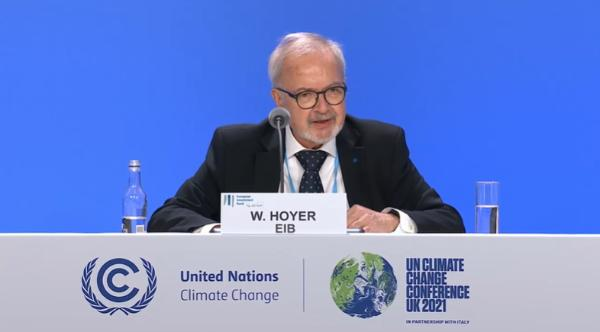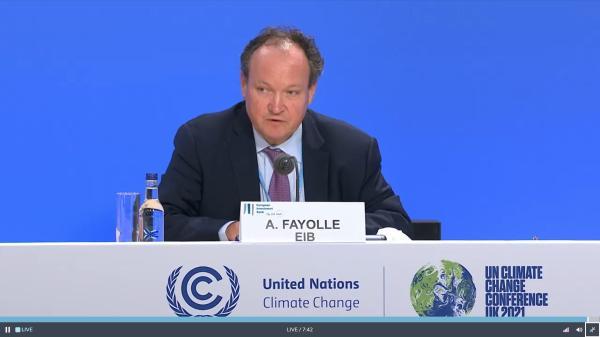President Werner Hoyer and Vice-President Ambroise Fayolle led the European Investment Bank’s press conference during COP26. Watch the press conference.
Check against delivery

Ladies and Gentlemen,
Thank you for joining us on Finance Day at COP26.
Let me congratulate the United Nations and the UK COP26 Presidency for organising this historic conference under the circumstances of the ongoing pandemic.
The United Nations has called the latest IPCC report a code red warning for humanity.
At the European Investment Bank, we have heard these warnings. We have listened to the calls from the COP26 presidency and the international community on how public banks like ours must do more to save the planet from global warming.
Last year, our shareholders, the EU member states, unanimously adopted our Climate Bank Roadmap.
The roadmap spells out just how we will support 1.1 trillion dollars of green investment by the end of this decade and dedicate more than 50% of our lending towards green investment by 2025, a commitment we made in November 2019.
With the roadmap, we have become the first multilateral development bank to align all financing activities with the goals of the Paris Agreement. This includes a stop to support for unabated fossil fuel energy projects, including natural gas.
As the EU climate bank, we realise we must do more. We recognise our dual role, not just as an incubator of climate finance but also of knowledge and know-how. Therefore, we are delighted to update you today on how the EIB Group is strengthening its leadership role in climate action.
Ladies and Gentlemen,
The keywords of the EIB for Glasgow are partnerships, innovation and development.
No organisation, large or small, can meet serious climate ambitions alone.
We have to partner with innovators and front-runners. Nudge each other along as a community. We have to create markets and drive change in order to have meaningful impact.
We have to partner worldwide with the growing wave of innovators, both in the developed and developing world.
Partnerships, Innovation, Development.
Yesterday we announced:
- A new partnership with European Commission President Ursula von der Leyen and Bill Gates’s Breakthrough Energy Catalyst to mobilise up to up to €820 million for new green technologies and solutions, scaling them up, and making them more affordable, so they can be deployed around the world. This includes support for green hydrogen, synthetic aviation fuel, direct air carbon capture and long-term energy storage.
- Together with the members of the Multilateral Development Bank community, we endorse the commitments on nature made in a Joint Statement, bringing together the climate and biodiversity agendas in order to respond to the dual emergencies.
To meet the Paris climate goals, we must switch to a green economy and create opportunities for the most vulnerable and affected.
Today WE ARE ALL transition economies!
We are currently working on a Just Transition proposal under our Climate Bank Roadmap, to make sure that our financing and our technical assistance will support a green future, in particular in the regions that have the furthest to go.
The International Labour Organization estimates that green economic policies could create 24 million jobs globally by 2030.
To use this opportunity fully, we must recast business, politics and society. We must rethink innovation, climate and development as one action.
Ladies and gentlemen, to limit global warming to 1.5°C, the global financial sector will need to align its activities with the Paris Agreement goals. We stand ready to play our role as EU climate bank to serve as a market maker and shaper… To serve as a channel of climate finance and climate know-how. Through our work on the EU taxonomy and pioneering the green bond market, we have been unwavering in our commitment to greening the global financial system and supporting the Paris Agreement goals. We continue on this path. And we take the expectations of the bank very seriously.
I now hand over to Vice-President Ambroise Fayolle to present two key announcements under our Climate Bank Roadmap.

Paris Alignment for counterparties
I am very pleased to announce two important deliverables under the EIB Group’s Climate Bank Roadmap that our shareholders, the EU Member States, agreed two weeks ago and that we will launch at COP26 in the coming days.
- The first is our new Framework for the Paris Alignment of Counterparts.
- The second is our new Adaptation Plan.
As some of you may know, last year, when we adopted our Climate Bank Roadmap, we introduced a clear and transparent set of criteria to ensure that all our projects, as of January 2021, are aligned to the goals of the Paris Agreement. For example, the EIB no longer supports projects related to the development of new airports, or the extension of capacity of existing ones. We have also reinforced our due diligence process by using a significantly increased cost of carbon in the economic analysis of our projects.
We have decided to go further in our approach and to go beyond the scope of our projects. Once again, we are treading new ground, as we are the first Multilateral Development Bank to look into this.
As a climate bank, it is not tenable to support a company to develop a low-carbon project if, at the same time, the company intends to develop and expand highly carbon-intensive projects as part of its wider activities. A clear example would be a coal-mining company looking to install solar panels to generate electricity to improve its mining activities.
The EIB Group has therefore developed a new approach to help support its beneficiaries – notably corporate and large financial institutions – to align their activities with the Paris Agreement.
Building on the emerging EU regulatory environment on sustainability reporting and disclosure, the EIB group will engage primarily with corporate clients in high-emitting sectors and seek to support their decarbonisation and resilience plans. Such plans must include “short-term” commitments – to 2030, and long-term commitments – to align with a net-zero carbon target by 2050. For large banks, the requirement will be to disclose their exposure to climate-related risks, as per the recommendations of the TCFD (Task force on Climate-related Financial Disclosures).
While the approach is centred around engagement and disclosure, it also needs a bottom line. That is why the new framework also introduces a list of activities, which it deems to be incompatible with the goals of the Paris Agreement – such as building new coal-fired power plants, or destroying high-carbon sinks such as tropical forests.
In general, the EIB will only support a low-carbon project with a corporate if it is not engaged in such incompatible investment in its wider activities.
The only exception to this general approach would be for projects with very high innovative value (for example, green hydrogen or advanced biofuel production), reflecting the intellectual property and technical expertise held by oil and gas majors that is crucial to achieving long-term deep decarbonisation.
Adaptation Plan
Last year, the EIB committed to increase the share of its finance dedicated to green investment to more than 50% by 2025. This investment supports the EU Green Deal and will be tracked according to the technical criteria agreed under the EU Taxonomy.
One key aspect of climate action is adaptation. This requires increased investment – partly to integrate adaptation considerations into all infrastructure projects – roads, railways, hospitals – such that these assets can withstand more frequent and more intense extreme weather events.
In addition, specific investment is needed to increase protection of coastal areas, develop flood protection and early-warning schemes, to green cities to reduce heat exposure, or develop more resistant crops.
The new EIB Adaptation Plan sets out the strategic approach of the Bank to increase and accelerate its support to adaptation activities. It fully supports the objectives of the EU Adaptation Strategy towards promoting adaptation that is smarter, more systemic and accelerated to support adaptation efforts inside and outside the EU. The plan sets out three goals for the Bank.
Firstly, to build EIB capacity in this area, informed by the latest science and partnering with key centres of expertise to deepen its interactions with clients, including both private and public sector. The plan launches a new ADAPT platform to provide access to advisory services for the formulation of adaptation plans at national, sub-national and entity level, capacity building and technical support for project development and implementation.
Secondly, the EIB pledges to accelerate its finance for adaptation. This translates into an increase of the share of adaptation support to 15% of the bank’s finance for climate action by 2025. This represents a three-fold increase compared to adaptation finance over the past five years. The plan sets out sector focus areas stretching across water, energy, transport, food systems and health, as well as reviewing the financial toolkit available to the Bank to support such projects.
Finally, the plan sets out opportunities for the Bank to support some of the most vulnerable countries in the world – least developed countries and Small Island Developing States. The proposed approach builds on closer cooperation with the Global Centre on Adaptation and the African Development Bank to accelerate action in African countries.